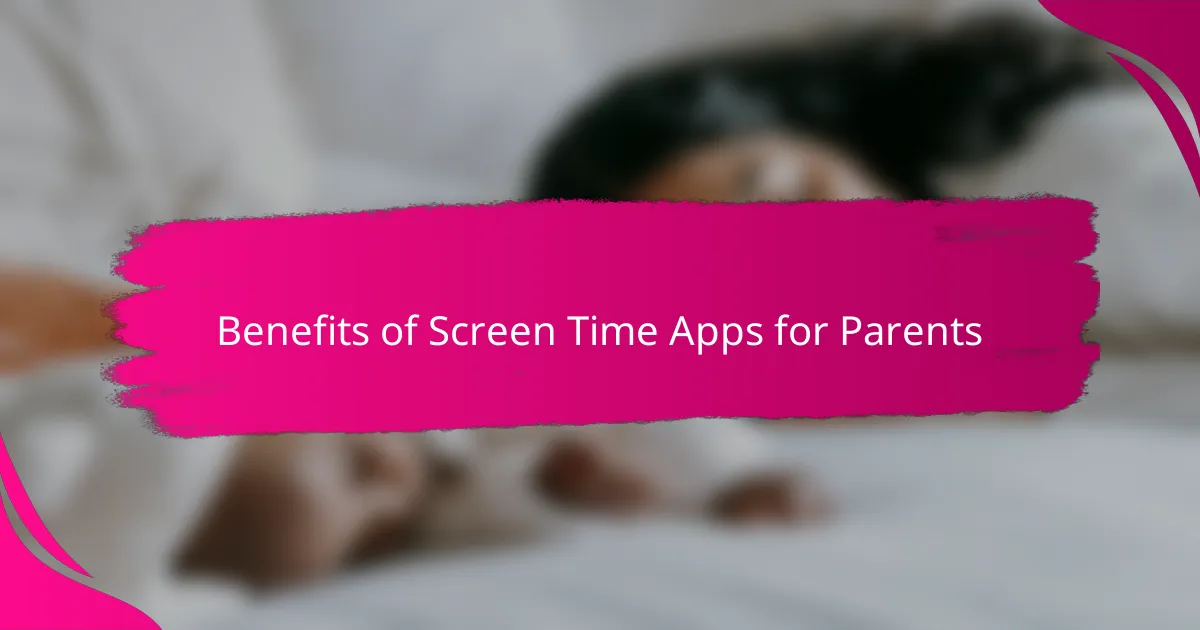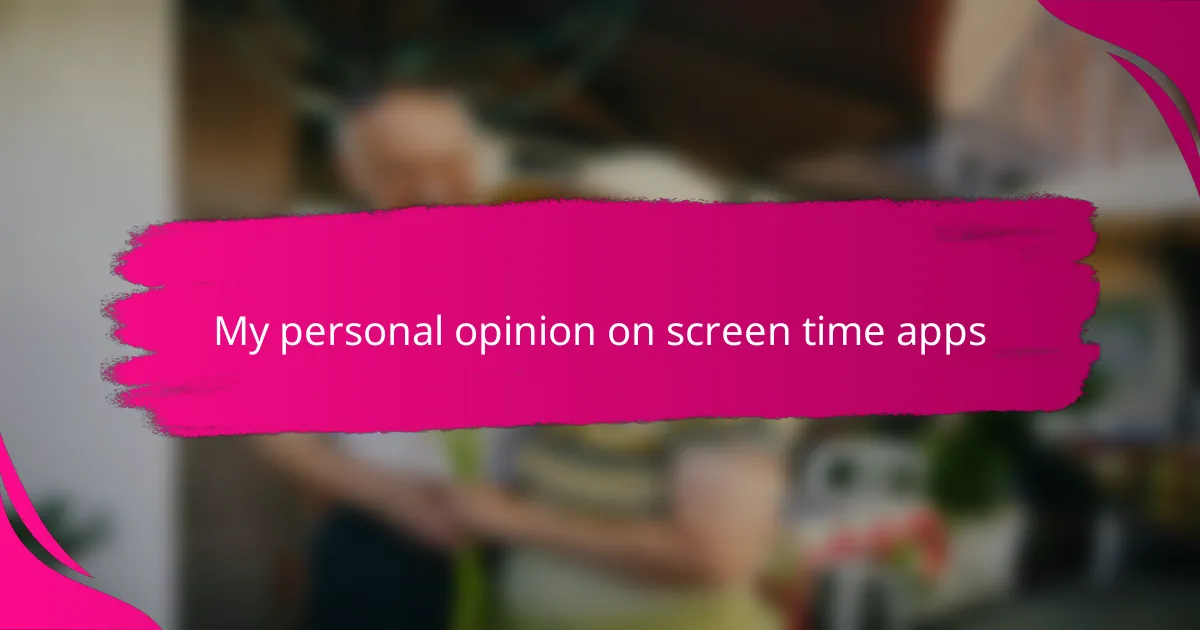Key takeaways
- Screen time apps help parents monitor usage, set flexible limits, and encourage healthy digital habits in children.
- Effective screen time management involves involving kids in limit-setting, combining device time with offline activities, and maintaining a balance between discipline and empathy.
- Challenges include kids finding workarounds, emotional reactions to limits, and the need for consistent engagement from parents for the apps to be effective.
- Choosing the right app should prioritize flexibility, security, privacy, and user-friendliness to ensure it serves both parents’ and children’s needs.

Understanding Screen Time Apps
Screen time apps are designed to help parents monitor and manage the amount of time their children spend on devices. From my experience, these tools offer more than just tracking; they provide a way to set boundaries that feel reasonable rather than restrictive. Have you ever wondered how much screen time is just enough? These apps give you a clearer answer by breaking down usage into categories, helping you see patterns you might otherwise miss.
Using screen time apps has taught me just how easily kids—and adults—can lose track of time when they’re engaged with screens. It’s surprising how a few minutes can quickly turn into hours without noticing. That realization brought a mix of concern and motivation for me. I started thinking, what if these apps could not only limit time but also encourage healthier digital habits? That’s the potential I see in understanding and using these tools thoughtfully.
Another aspect I appreciate is how customizable these apps are. As a parent, no two children are the same, and the flexibility to tailor settings based on age or activities truly makes a difference. It’s not about enforcing strict limits but about creating a balance that respects individual needs. This approach feels less like control and more like guidance—a distinction I believe is crucial in fostering trust and cooperation.

Benefits of Screen Time Apps for Parents
One of the biggest benefits I’ve noticed with screen time apps is the peace of mind they bring. Knowing exactly how long my child is on their device, and what they’re engaging with, eases a lot of my anxiety as a parent. It’s like having a digital safety net that helps me stay informed without having to hover constantly.
Have you ever struggled to get your kid off a screen without turning it into a battle? For me, these apps have been game-changers in reducing those daily power struggles. Setting agreed-upon limits together turns a potentially tense moment into a shared understanding, which makes everyone’s day smoother and less stressful.
What’s more, these apps empower me to teach my children self-discipline rather than just imposing rules. Watching them learn to manage their own time on devices has been rewarding—it’s a skill they’ll need well beyond their childhood. I’ve seen firsthand how this kind of guidance builds confidence and respect, rather than rebellion.

Challenges of Using Screen Time Apps
Sometimes, despite all the customization options, I’ve found screen time apps can feel a bit too rigid. Kids are creative, and my child once figured out a workaround that made me realize these tools aren’t foolproof. Have you noticed how quickly they adapt? It’s a reminder that tech solutions need our ongoing attention and adjustment.
Another challenge is the emotional pushback. I’ve seen moments when my child reacted with frustration or disappointment when the app cut off their screen time mid-game. It made me question whether these limits were hurting our relationship more than helping. Balancing discipline with empathy is tougher than any app setting, and that’s something no software can fully capture.
Lastly, I’ve struggled a bit with consistency. Life gets busy, and sometimes the notifications or reports from the app get buried in my inbox, making it easy to lose track. Have you ever started a routine but then let it slip? It’s a human flaw, and in my experience, relying solely on an app without intentional follow-through can limit its effectiveness. The technology helps, but commitment from us parents is still key.

Personal Experiences with Screen Time Apps
I remember the first time I set up a screen time app for my child—it felt empowering to have concrete data rather than vague worries. But soon enough, I noticed how that initial confidence gave way to moments of doubt, especially when my child tried to negotiate more time. Have you experienced that tug-of-war between wanting to enforce limits and wanting to keep the peace? It’s a delicate dance that no app alone can choreograph.
There was a day when I checked the app’s daily report and saw my child had spent nearly three hours on a game I hadn’t even heard of. That surprised me and sparked an honest conversation about choices and priorities. I often reflect on how these moments, prompted by the app’s insights, opened doors to communication I hadn’t prioritized before.
At times, I’ve grappled with feeling guilty whenever I extended screen time “just this once” because the app’s schedule felt too strict for that day’s circumstances. Can flexibility coexist with consistency? My experience tells me it can, but only if we approach these apps as tools—not rules carved in stone—always adjusting to our family’s unique rhythm.

Tips for Effective Screen Time Management
One tip I’ve found essential is involving kids in setting their screen time limits. Instead of just imposing rules, asking them what feels fair creates a sense of ownership. Have you tried this? It’s amazing how cooperation replaces resistance when children feel heard.
Another strategy I rely on is combining screen time apps with routine offline activities. For example, scheduling reading or outdoor play right after device time helps my kids shift focus more smoothly. From my experience, this transition reduces those sneaky moments when screens become the default option.
Lastly, consistency is key—but so is flexibility. Life throws curveballs, and sometimes extending screen time makes sense. I’ve learned to adjust app settings when needed, keeping the overall goal in mind rather than sticking rigidly to a preset schedule. Does this balance make managing screen time feel less stressful for you too? It certainly does for me.

Balancing Screen Time and Family Activities
Finding the right balance between screen time and family activities isn’t always straightforward. I’ve noticed that when we plan engaging family moments—like board games or outdoor adventures—it naturally pulls my kids away from their screens without needing strict time caps. Have you tried shifting focus to meaningful interactions rather than just limiting devices? From my experience, it changes the whole dynamic.
Sometimes, though, it feels like a tug-of-war when screens seem more appealing than anything else on the agenda. In those moments, I’ve realized that screen time apps alone can’t create connection; they can only help by freeing up space on the clock. It takes intentional effort from all of us to fill that space with fun, shared experiences.
What’s been most eye-opening for me is seeing how setting aside device-free times encourages real conversations and laughter that screens can’t replace. Maybe it’s less about cutting down screen time and more about making family time so compelling that screens naturally take a backseat. Have you felt the difference when everyone’s fully present? That’s when this balance starts to feel doable—and deeply rewarding.

Recommendations for Choosing Screen Time Apps
When choosing a screen time app, I always look for one that feels flexible rather than just restrictive. Have you ever tried an app that made everyone feel boxed in? From my experience, the best tools allow customization for different ages and activities so that limits fit your child’s unique needs rather than imposing a one-size-fits-all rule. This approach helps keep both parents and kids on board without breeding resentment.
Security and privacy are another big concern I keep in mind. It’s tempting to pick an app with lots of features, but I’ve learned to check how the app handles data because nothing’s more important than protecting your family’s information. Does the app share data with third parties? Can you control what info gets collected? Asking these questions upfront saves headaches later—and keeps trust intact.
Lastly, the app’s ease of use matters more than I expected. If it’s complicated for me, it’ll be a nightmare for my child too. I’ve found that apps with clear interfaces and simple controls make negotiations smoother and daily monitoring less stressful. Isn’t it a relief when technology actually helps rather than adds to the chaos? That’s always my goal when selecting a screen time app.
